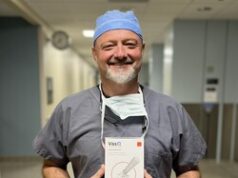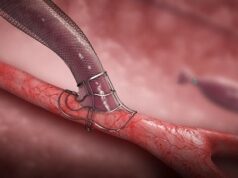
Intraoperative ultrasonographic venous mapping is a useful tool to evaluate vessel suitability for arteriovenous fistula (AVF) creation, Yana Etkin (Zucker School of Medicine at Hofstra/Northwell, Lake Success, USA) concluded at this year’s Society for Vascular Surgery (SVS) Vascular Annual Meeting (VAM 2022; 15–18 June, Boston, USA).
According to the presenter, the technique may increase the rate of distal fistula creation and lower the rate of graft replacement, and therefore “should be incorporated into routine clinical practice”.
Etkin and colleagues note in the abstract of their study that there is currently no consensus on how best to evaluate the suitability of vessels for AVF creation. They write that use of preoperative sonographic vascular mapping performed by a vascular imaging facility is common despite a lack of evidence on AVF outcomes. The goal of the present study was to evaluate the utility of intraoperative vascular mapping performed by the operating surgeon during access creation.
The research team performed a single-institution, retrospective study of 239 AVFs that were created in their institution between 2019 and 2021, Etkin informed the VAM audience. The team only included patients who had intraoperative and preoperative vein measurements recorded. The presenter detailed that the operating surgeon performed intraoperative measurements and that the certified vascular lab carried out preoperative measurements.
Etkin noted that site selection for fistula creation was based on distal to proximal and superficial vein first approach. This meant that the team considered radiocephalic fistulas first followed by brachiocephalic and then brachiobasilic fistulas, the presenter explained. Veins with a diameter of at least 2mm on intraoperative mapping were used for fistula creation.
The investigators compared intraoperative measurements of the veins used for fistula creation to preoperative measurements of the veins in the same anatomic location, the presenter explained. She added that the researchers reviewed the preoperative mapping and analysed which haemodialysis access would have been created if intraoperative mapping was not performed.
The presenter reported at VAM that, on average, intraoperative vein measurements were about 1mm larger than preoperative vein diameters (3.6mm vs. 2.5mm) and that this was consistent in all anatomic sites including forearm cephalic vein, upper arm cephalic vein and basilic vein. The team also found that anaesthesia type did not significantly affect intraoperative measurements. In patients who had regional anaesthesia, the mean intraoperative vein diameter was about 3.6mm, compared to 3.4mm in patients who had local anaesthesia.
When looking at preoperative mapping alone, Etkin revealed that 71% of patients would have the same access created. Ten percent of patients would require a more proximal fistula created utilising superficial veins, 13% of patients would have fistulas created using deep veins, and 6% of patients would require a graft, the presenter added. In this subset of 70 patients who had a different access created based on intraoperative mapping, maturation rates were similar, at 84% as compared to 88% in the rest of the cohort.
Etkin noted that there were several limitations to the study. She reiterated that this was a single-institution, retrospective study, and that only a small number of patients were included.
In the discussion following Etkin’s presentation, one audience member expressed their “surprise” that type of anaesthesia did not appear to affect AVF creation in the study. “Is it perhaps sedation that causes vasodilation as opposed to the type of anaesthesia?” they asked the presenter. “This is something we are looking at,” replied Etkin. “It might be sedation.” However, due to the small sample size of the study, she stressed that the team needs to collect data from more patients in order to carry out such an analysis.
Another VAM delegate asked whether preoperative vein mapping might correlate better if it is performed well after the time of dialysis, stressing that the patients could be dehydrated when they come in for mapping. “That is the question that is almost impossible to answer,” the presenter replied. “We always operate the day after dialysis, but preoperative mapping might have been done on the day of dialysis, when the patient is dehydrated. It is very hard to tell what their fluid status is during mapping.”
There was widespread agreement with Etkin’s conclusions among the VAM audience, with one delegate likening the research to a consensus statement. This prompted the presenter to question why the guidelines do not yet endorse the intraoperative mapping as a standard of care. “That is why we wanted to put these data out there, to see if there is interest in adding the recommendation of intraoperative mapping into national guidelines”.














I read this report with interest. I agree wholeheartedly that intra operative vein.mapping should be routine. Anecdotally we have found day of surgery post induction vein measurements are indeed larger and have led to change of plan fistula formation instead of planned graft placement. Our practice tends to map a certain percentage of patients on their dialysis days which I believe leads to measurements in a relatively dehydrated patient. Presence and use of a high quality portable ultrasound unit is of paramount importance.
These findings are mine since years, and the use of US in my practice.
The best timing for mapping is the morning before surgery, in the bed with blanket to create WARM conditions, and the use of television that gives relaxing conditions.
It can also be after an axillary blockade and also warm conditions with an electric blanket.
To send a patient for mapping or US examination just after a dialysis session is a big mistake that leads to wrong surgery!